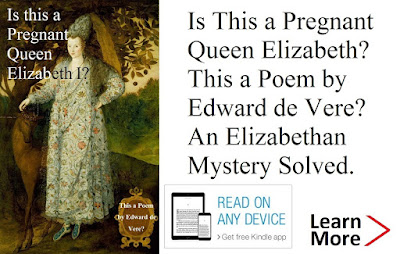THE following transcript of an original document has been
sent to us by a gentleman of such eminent and unquestionable knowledge and
accuracy that we do not scruple to print it. It places the — Queen and the Earl
of Leicester in a very odd juxtaposition.
Some people may perhaps feel inclined to draw large
conclusions from it. For ourselves, we do not think it warrants anything of the
kind. If such conclusions had been thought justly to result from it by those by
whom it was prepared — and they must have known much more of the matter than we
can do — we may rest assured that this document never would have been penned.
With this protest on our own behalf, we print it without hesitation, as ever
friendly to the utmost latitude of inquiry. We shall have an opportunity
shortly of treating the whole question of the degree of intimacy between
Elizabeth and the powerful Earl.
Writ or Privy SEAL,
[From the Collection of the late Sir William Musgrave, Bart.]
By the Quene.
ELIZABETH.
‘We woll and commaunde you that uppon the sight hereof ye
delyver or cause to be delyvered unto our servaunt Walter Fyshe twelve yards of
purple vellat[1],
frized[2]
on the back syde with white and russet sylke, to make us a nyght gowne; and
also that ye delyver to Charles Smyth, page of our robes, fourtene yards of murrye[3]
damaske, to be employed in making of a night gowne for the Erle of Leycester.
And two hole peces of crymeson silke chamlet stryped with golde, the one
conteyning xxx. yerds quarter dim.[4]
to make Fraunces Haward and Elizabeth Knolls of our Privie Chamber, eyther of
them, a trayne gowne; whiche parcells remayne in your custody and chardge. And
these our letters signed with oure hand shalbe your sufficient warraunt and
dischardge for the deliverye thereof. Yeven[5]
under our signet at our Pallaice of Westminster, the xxviiito daye
of Marche, in the xiiijto yere of our rayne.
“To our trusty and welbeloved servant George Bredyman, Keper
of our said Pallaice of Westminster.”
A Mr. Craven Ord, Esq. read the writ and four others before
the Society of Antiquaries of London on May 1, 1806, after which they were published
in the society’s journal Archaelogia[6]. All were said to come from the collections of
one Sir William Musgrave. Whether Ord was the “gentleman of such eminent and
unquestionable knowledge and accuracy” is not stated.
A second writ was read in the matter of the Earl of
Leicester’s gifts from the queen. This time of a lavishly outfitted “staff”.
The date of the writ was the 22nd of September 1565 [N.S.], just
over a week before the first anniversary of the day the Queen created Robert
Dudley Earl of Leicester. She clearly wished to celebrate that first
anniversary with a gift to take the breath away.
BY THE QUENE.
ELIZABETH,
"We woll and comaunde you that uppon the sight hereof ye
delyver or cause to be delyverid for our owne use unto Master Fishe our Tayler
theise parcells following viz. Nynetene yardes & a half of tawny cloth of
silver tyssued with gold and silver Sixe yardes of murrie vellat half a yarde
of murry satten The riche border and garde of crymesyn vellat embroiderid with
damaske golde, pearle and small headstones of golde that is upon the gowne of
crymesyn vellat and crymesyn satten alover embroderid with pirles[7]
of damaske golde and silver and also one forepart of a kyrtell of crymesyn
satten allover embroderid with perle[8]
and pearle. Furder we will that ye delyver unto my Lord of Leycester of oure
gift one staffe coverid with black frized vella[t] garnished with golde having
uppon the toppe a perfume of golde, under that a penner of golde, a diall of
golde, an inkpot of golde, a knyffe the haft of golde, a fyle the haft of
golde, a rule and a compass of golde, a whetstone tipped with golde, and a
virrall[9]
of golde at the nether ende. All whiche parcells remayne in your custodie and
chardge at oure Pallaice of Westm'. And these our letters signed with oure
signe manuell shalbe your sufficient warraunt and discharge for the delyverie
thereof Yeoven at our saide Pallaice the xxijto of Septemb~ in the
vij yeare of our raigne.
To our Trustie and welbeloved s'vnt George Bredyman keper of
our saide pallaice of Westm.
Even more detail appears in these writs than might at first be realized. George Bredyman was the
keeper of White Hall Palace, at Westminster, since the final weeks of the reign
of Mary, and would continue until his death in 1581. In the earlier writ, Walter
Fyshe was the Queen’s tailor. His skills were apparently appreciated as in 1573
the Queen’s Keeper of the Apparel, John Arnolde, died and was replaced by
Fyshe. Thus we find him styled “our servaunt Walter Fyshe” in the later writ. Presumably
one of Fyshe’s assistants, Charles Smyth, was styled Page of the Robes.
[1]
vellat] velvet
[2] frizzed] lined with long-nap wool
[3] murrye,
murrie, etc.] murrey. Mulberry colored. Purple.
[4]
dim.] damask
[5] Yeven]
Given.
[6] Archaeologia
Or Miscellaneous Tracts Relating to Antiquity, Volume 16.
[7]
pirles] purls, purlings. The entire phrase is “crimson satin embroidered all
over with purls of damask gold and silver”.
[8]
perle] purl, purling
[9]
virall] ferrule
Also at Virtual Grub Street:





No comments:
Post a Comment